Must Reads: Here’s how Paradise ignored warnings and became a deathtrap
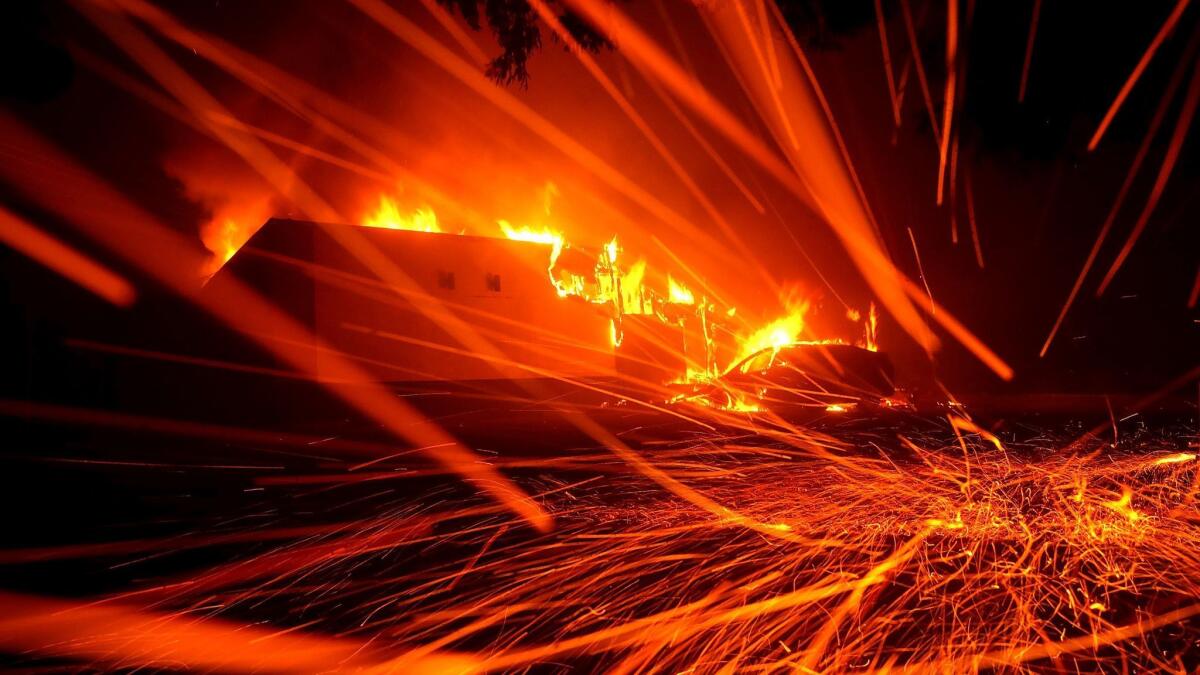
Reporting from Paradise, Calif. — The fate of Paradise was cast long before a windstorm last month fueled the deadliest fire in California history.
The ridge settlement was doomed by its proximity to a crack in the mighty wall of the Sierra Nevada, a deep canyon that bellowed gale-force winds.
It was doomed by its maze of haphazard lanes and dead-end roads that paid no heed to escape.
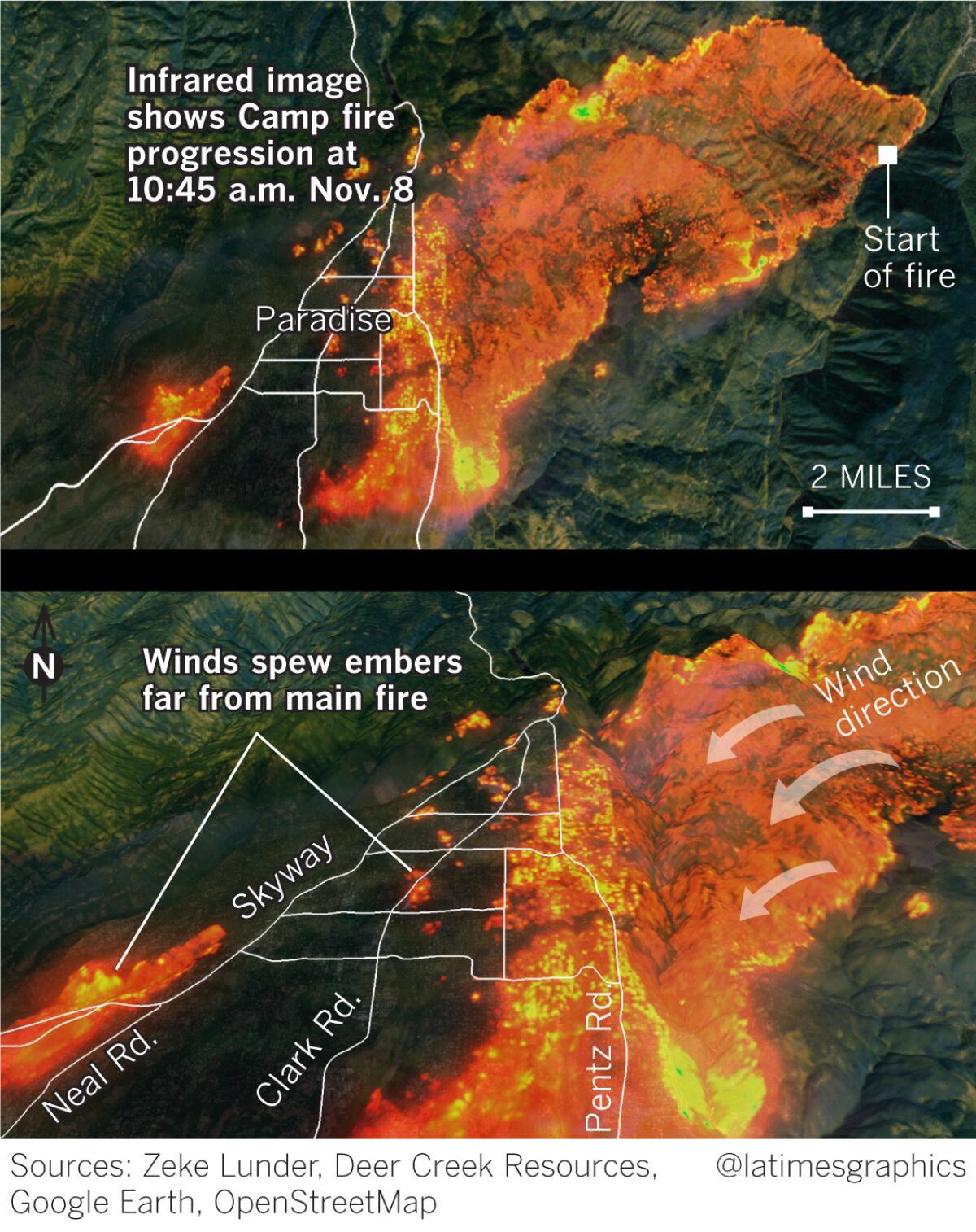
It remained doomed because for all the preparations community leaders made, they practiced for tamer wildfires that frequently burned to the edge of town and stopped — not a wind-driven ember storm.
In the aftermath of the Camp fire — 86 dead, more than 13,900 homes destroyed and Paradise decimated — local and state officials said the tragedy was unforeseen and unavoidable, an “unprecedented” monster of fire.
In truth, the destruction was utterly predictable, and the community’s struggles to deal with the fire were the result of lessons forgotten and warnings ignored. The miracle of the tragedy, local officials now concede, is how many people escaped.
A Los Angeles Times investigation found that Paradise ignored repeated warnings of the risk its residents faced, crafted no plan to evacuate the area all at once, entrusted public alerts to a system vulnerable to fire, and did not sound citywide orders to flee even as a hail of fire rained down.
Historical records show the Camp fire was typical of the catastrophic wind-driven fires responsible for California’s greatest wildfire losses.
A state fire planning document warned in 2005 that Paradise risked an ember firestorm akin to the one that ripped through Berkeley and Oakland 14 years earlier, killing more than two dozen people and destroying more than 2,000 homes. But Paradise officials framed risk in historical terms: In 50 years, no wildfire had crossed the Feather River.
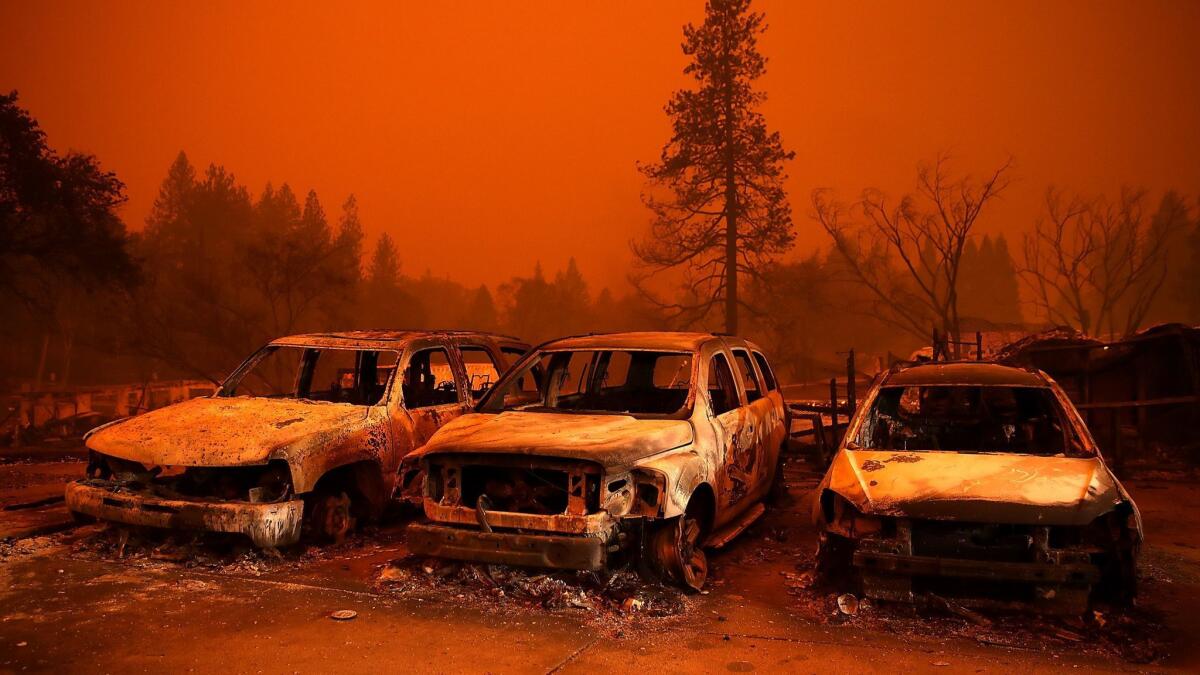
The roads out of Paradise gridlocked within an hour of the first evacuation order, and began moving again only by a herculean effort of firefighters, police, bureaucrats and politicians who rushed to jammed intersections to try to unsnarl the knot, the benefit of having practiced for small fires.
In another three hours, hundreds of residents were trapped deep within town, cut off by flames. The town communications system was dead, as were cell towers. Police radios were crippled.
People jumped from cars and fled on foot. Hundreds sought refuge in parking lots and commercial buildings never intended to be temporary shelters in a firestorm. The remains of scores of residents were found inside the homes they never left.
The disaster occurred despite the fact that Paradise was proactive about preparing for fire, not just with drills and plans, but advertising its warning system, promoting “pack and go” preparations by residents, and even writing fire precautions into public construction projects. City leaders believed no other California community, except perhaps fire-dogged San Diego, was better prepared.
National transportation planners say the town’s destruction should set a new bar for emergency planners in wildfire areas, the way Hurricane Katrina reshaped evacuation planning on the Gulf Coast. But despite vows to create statewide evacuation standards after previous deadly wildfires, California has yet to take action and evacuation planning remains a local responsibility.
The question is more urgent than ever after two wildfire seasons with a staggering death toll: More than 40 killed by fires in wine country, more than 20 dead from the Montecito mudslides.
But experts fear the lessons will go unheeded.
“Memories are very short and people will soon forget how terrible Paradise was,” said Michael Robinson, director of the Center for Innovative Transportation Solutions at Old Dominion University, which helps communities plan for evacuations. “Or they’ll think, ‘It was terrible for Paradise, but it won’t happen to me.’”

Drone video showing charred remains of the Ridgewood Mobile Home Park after the Camp fire
An imperfect place
Paradise was built upon a system of volcanic ledges bisected by a fan of deep ravines emptying into the Sacramento Valley.
Developers started with what had been gold mine trails and then apple orchard roads to pave a street system that maximized buildable space the way blood vessels branch into capillaries. There are nearly 100 miles of private roads that dead-end on narrow overlooks and few connector streets.
For more than 38,000 people, access to the outside world came via four roads running south, down finger ridges and through forest canopy. After 2008, a forest road north was paved to provide escape for residents on the upper ridge above Paradise. On the day of the fire, the narrow winding passage jammed and was impassable.
Other historic mining towns in the Sierra Nevada foothills follow similar chaotic, organic layouts.
“The DNA of these towns is such that they’re … set up for disaster,” said Zeke Lunder, a Chico-based fire specialist and geographer whose company helps private landowners and public agencies conduct prescribed burns and prepare for inevitable wildfires.
The population boom for Paradise came in the 1960s and ’70s. Nine out of 10 homes were built before 1990 and most were more than three decades old. Tax assessor records show that only 285 homes were built on the Paradise ridge since new fire codes went into effect in 2008. A Times analysis of assessor records and fire surveys showed those newer structures had a 13% survival rate in the Camp fire, compared with 3% for older homes.
Paradise officials repeatedly told The Times they never envisioned a firestorm reaching the town.
But the 2005 state fire management plan for the ridge, developed in consultation with some of those same Paradise planners, warned that canyon winds posed a “serious threat” to Paradise.
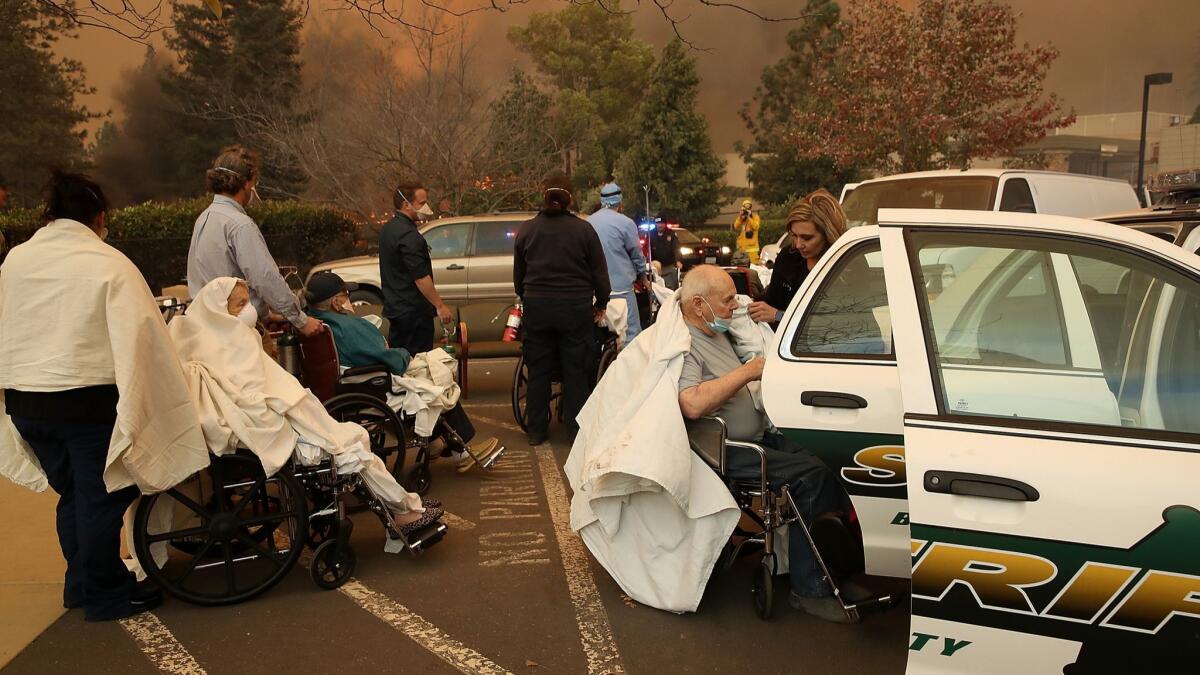
The “greatest risk” was an “east wind” fire, the document said, “the same type of fire that impacted the Oakland Berkeley Hills during the Oct. 20, 1991, firestorm” that killed 25 people.
The plan also warned of “a high potential for large damaging fires and loss of life and property” in the Concow Basin beside Paradise. “Heavy fuel loads, steep terrain, poor access and light flashy fuels create severe fire hazards. The increased population in this area creates a high potential for catastrophic life and property loss.”
Subsequent fire plans created by Butte County and Paradise officials in conjunction with the California Department of Forestry and Fire Protection use much less direct language. Those plans warn only of “extreme” fire, a step below catastrophic. Canyon wind fires are not mentioned at all.
The town’s vulnerability to fire was evident in 2008, first by the Humboldt fire that destroyed 87 homes west of Paradise, then a week later by a lightning storm that sparked dozens of fires to the east. Residents trying to flee were caught in massive traffic jams, flames burning on both sides of the road as they sat trapped in their cars. One person died of a heart attack.
The 2008 fires primed the land around Paradise to burn again, Lunder said, leaving both dead timber and open spaces for thick grass. It was as if the gun had been cocked.
A year later, the Butte County grand jury warned that the town faced disastrous consequences if it did not address the capacity limits of its roads. But Butte County supervisors and planners rejected the panel’s call for a halt to growth until the evacuation problem was met.
The largest paper in Chico ran an editorial concluding that sufficient evacuation roads could not be built, and that those who chose to live in Paradise needed to be aware of the risk they took and be prepared to leave early.
Five of the grand jurors, interviewed by The Times, said the improvements that were made — paving of the forest road and straightening of another route — were inadequate. They felt they had been ignored.
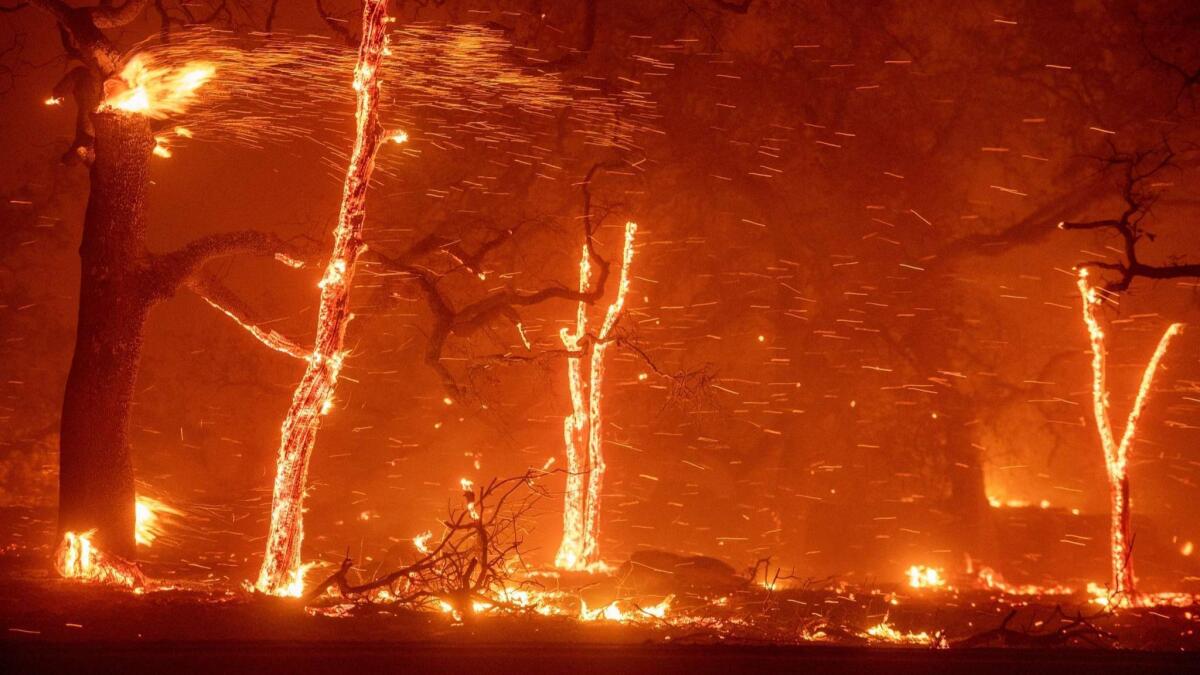
Among them was Walt Sipher, a Chico resident whose sister followed their parents to Paradise and remained on the ridge after they died. Sipher called his sister the morning of the Camp fire to warn her to leave. She told him she didn’t need to — it would be contained.
Judith Sipher was typical of those who perished that day: elderly, infirm with congestive heart failure and ill in bed with the flu. She had a car but seldom drove.
Walt tried driving into Paradise to fetch her, but hit blocked traffic and could not get in. He was summoned weeks later to the old Sears store in Chico to submit a saliva sample for the coroner, who was using DNA to identify the human remains found in his sister’s apartment.
“There are a lot of folks on that ridge, and so few escape routes,” Sipher said. “The possibility was always on everybody’s mind. … You hope it’s not going to be that bad, but it was.”
Narrowing the main road out
The same month the grand jury released its June 2009 report, Paradise was deep into plans to narrow its main evacuation route, Skyway.
Eight pedestrians had been injured by passing cars in the narrow business district, and heavy traffic gave the strip an “expressway” feel. The engineering firm that designed the project said it would reduce the number of vehicles that could pass through and advised against further “improvements,” such as a concrete median, citing the need to remember that the road was a fire evacuation route. More than half the ridge population lived above the strip.
Town recordings show a lone voice of concern at the 2014 council meeting giving final approval to the road narrowing.
“The main thing is fire danger,” said Mildred Eselin, 88. “If the council is searching for a way to diminish the population of Paradise, this would be the way to do it.”
City Fire Chief David Hawks pointed to Paradise’s plan to evacuate neighborhood by neighborhood rather than all at once.
“When everybody tries to evacuate at one time, that’s when the bottleneck creates,” Hawks said.
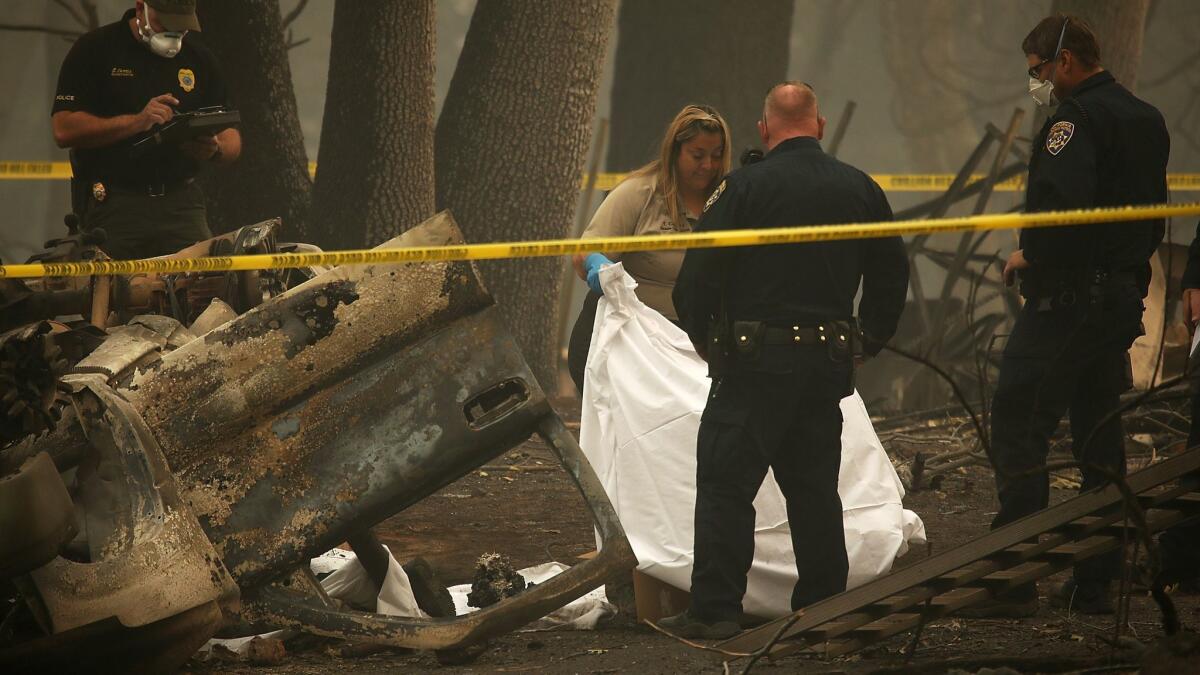
Not preparing for the worst
Staggered evacuations have been at the heart of Paradise evacuation plans since 1998. An updated plan approved in March 2015 codified decisions after the 2008 fires to convert Skyway into a one-way route during emergencies, doubling its capacity for evacuations. The town practiced its plan during a 2016 drill, part of regular mock disasters, and warned residents ahead of time so they could detour if need be.
Jim Broshears, the city’s emergency management director during the fire and its former longtime fire chief, estimated Paradise’s roads could support the combined evacuation of four zones in two hours — less than a fourth of the population. But city officials told The Times they had no idea how long it would take to empty the entire town. They said they never envisioned a need.
“We trained on what was most probable,” said town engineer Marc Mattox.
Planning for a firestorm would have been “akin to, ‘Is the L.A. Basin in its entirety planned for an earthquake that may devastate the L.A. Basin?’” Hawks said. “I don’t think that’s realistic.
“Obviously, it’s the largest or most devastating fire in California’s history,” he said. “It didn’t get that [way] because it was a normal event.”
Traffic simulation software housed at Old Dominion University and required by the Federal Emergency Management Agency for emergency plans around nuclear power plants was used by The Times to analyze Paradise’s roads. It showed the entire town would need eight hours for residents to leave under blue sky conditions, and more than five hours if Skyway were immediately converted to one-way traffic out.
Those estimates are without a rain of embers, burning obstacles, exploding propane tanks and heat blasts that melted tires. They do not account for roads that were blocked by falling power poles and abandoned cars the day of the fire or the two hours that it took police to establish one-way traffic on Skyway.
Paradise did not make use of such software. Told of The Times’ findings, Mattox said he would have liked to have had that information before Nov. 8. “Every public works planner, every emergency planner across the country should be aware about what those types of models would say for their community,” he said.
Broshears, the architect of most of the town’s emergency plan, and others acknowledge their plans were built around the sort of slower-moving wildfire Paradise had seen in the past.
“Let’s all just be honest,” Broshears said. “We didn’t have a plan that addressed a fire that would be everywhere. ...We had an evacuation plan built for a wildland fire. We had a hydrogen bomb. ... We were so overmatched.”
Failing to prepare for the larger disaster is hardly unique to Paradise, said former FEMA Administrator Craig Fugate.
Flaws in such planning are so common that Fugate describes them as the “deadly sins” of emergency management: Practicing drills that guarantee success; assuming that plans can be scaled up when a massive disaster strikes; relying on government systems to work under pressure; failing to plan how to protect vulnerable populations, such as the elderly; and mistrusting the public, which often leads to not warning the public early enough.
“We plan for what we’re capable of, and we hope it isn’t any worse,” he said.
Walt Scherer, who lost an earlier house to fire in the foothills of Loomis, where he was a city official, moved to Paradise in April and knew there was high fire risk. Again he lost his house.
He said he was stunned when he later heard Paradise’s mayor answer a public question about the snarled fire evacuation by stating that enough roads could never be built to evacuate the whole town at once.
“Anybody in their right mind would know that the whole town was a large oak forest, and everybody was at risk,” Scherer said. It was a “colossal failure,” he added, not to warn residents that the entire community couldn’t be evacuated at once. “You’ve got to recognize the risk.”
Firebrands and embers
The Feather River Canyon, where the Camp fire began, was well-known for high winds. The so-called Jarbo Gap winds rocket down the canyon from the northeast every fall, caused by high-pressure air parked over the Great Basin seeking a path through the Sierra Nevada to fill the low-pressure voids on the California coast.
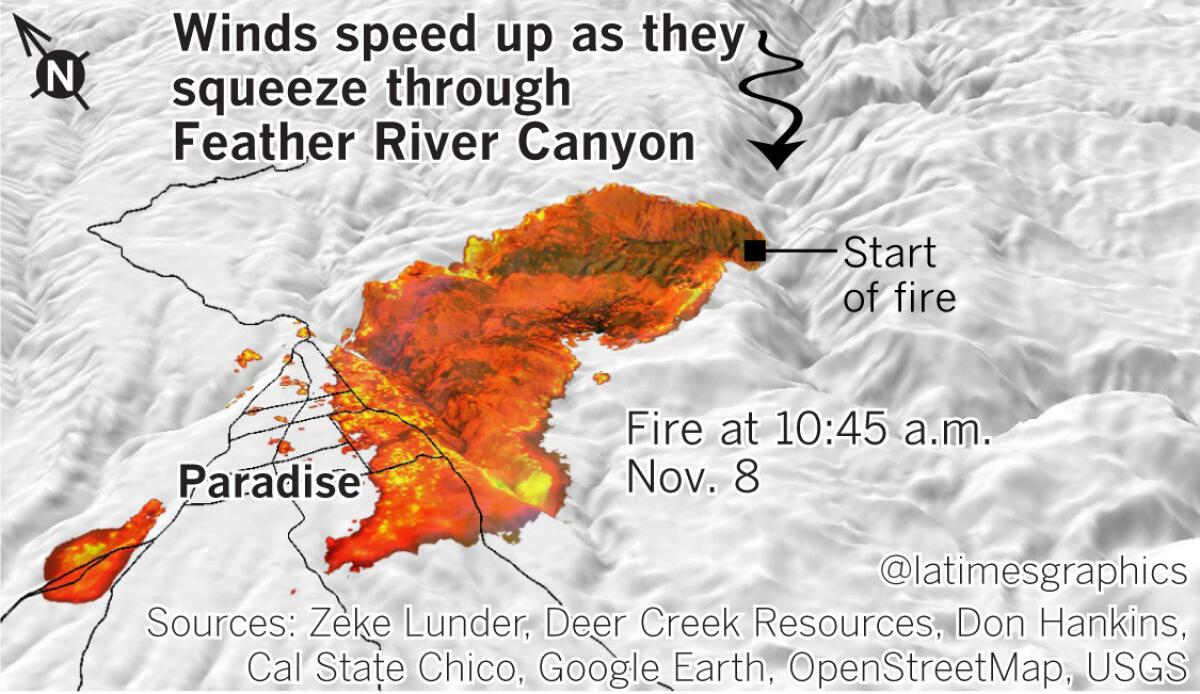
Meteorological records show 36 days since 2003 with gusts of 100 mph or more, and as high as 200 mph. Paradise sat in the path.
The morning the Camp fire ignited, the drying winds had been blowing for a week. According to weather equipment atop the fire station at Jarbo Gap, the probability that a single spark would ignite a fire big enough that fire crews would be needed to put it out was 76%. The station recorded gusts of up to 52 mph hours before the fire.
Rather than spreading as a flame front working its way through the forest, the Camp fire became wind-borne, lofting firebrands and embers that landed like rain. They fell on receptive fuels — trees and brush stressed by several years of drought, thick grass grown during heavy spring rains and now dry. The fuels also contained stands of gray pine, notorious for spouting embers.
The fire grew at a rapid clip — about 4,600 acres an hour, according to a Times analysis of fire maps and satellite imagery. Town and state fire officials called the speed of the fire unprecedented.
But the analysis shows other devastating California fires moved as fast, or faster.
In San Diego, the Cedar fire in 2003 kindled for hours until a Santa Ana wind rolled in at midnight. By 3 a.m., the wind-driven fire had jumped a river and a reservoir and ran nearly 17 miles. In the three-hour run, the fire spread an average of more than 19,600 acres an hour. Fifteen people were killed and more than 2,200 homes destroyed.
The Tubbs fire in 2017 matched the Camp in speed, roaring 12 miles in four hours into Santa Rosa, killing 22 people and eventually destroying more than 5,000 homes.
As the Camp fire blew into Paradise, the same high-pressure, low-pressure gradient set up a Santa Ana wind event that pushed the Woolsey fire into Malibu. Its pace in the first three hours was 21,290 acres an hour.
After the Camp fire was reported at 6:31 a.m., the wind carried embers to nearby Concow, where a mandatory evacuation order was demoted to “warning” status at 7:17 a.m.
Fifteen minutes later, embers were setting houses in Concow on fire and the evacuation order became mandatory. In short order firefighters were trapped with residents who had no time to flee. They deployed their fire shelters. Some people jumped into a lake.
The bodies of at least six people were found outside or inside their cars.
No warnings
In Paradise, the first order to evacuate part of the city came at 7:57 a.m., and the first report of fire at the edge of town two minutes later. Immediately there were a dozen spot fires in town.
The ember storm hailed on most of the town at once. Within an hour, spot fires were spread halfway across Paradise, congealing into substantial fires in backyards and on houses. They primed Paradise for the big burn hours before the arrival of the main wildfire, creating an urban firestorm that moved horizontally house to house and left trees overhead untouched.
As planned, evacuation orders began zone by zone. Calls, texts and emails were sent via CodeRed, a private service that contracted for the city and county.
But interviews and records released by the city and county show the emergency warning system failed on many levels.
Only a fraction of Paradise residents were signed up for the service — city officials at first estimated there was no better than 30% enrollment, then later told The Times they did not have access to the subscription list.
Many of the emergency alerts failed to go through — CodeRed logs showed initial call failure rates of 40%, climbing to 60% as the fire progressed. Many subscribers told The Times they never received calls.
A large portion of Paradise received no evacuation order before the fire.
Documents released under the state’s Public Records Act show that three of Paradise’s 14 zones received only warnings — not mandatory orders to leave — the morning of the fire, and no notifications at all were sent to three others. The loss of fiber optic lines and cell towers shut down the warnings entirely — Paradise police abandoned their dispatch center without ever sending a citywide order for other residents to flee.
Most residents said they relied on word of mouth, emergency vehicles driving down their streets with loudspeakers, or the sight of flames.
‘Get people moving now!’
It took only an hour for Paradise to jam so thoroughly that a sheriff’s sergeant jumped on the radio, his voice urgent.
“Flames!” he shouted. “Get people moving now!”
The order to open all of Skyway to one-way traffic finally came, but what took 45 minutes during a mock drill required an hour under fire conditions. The road wasn’t fully converted to one-way traffic until shortly after 10 a.m. By then, dispatch recordings indicate that Skyway was choked down to Chico, and entire stretches began to be lost to fire.
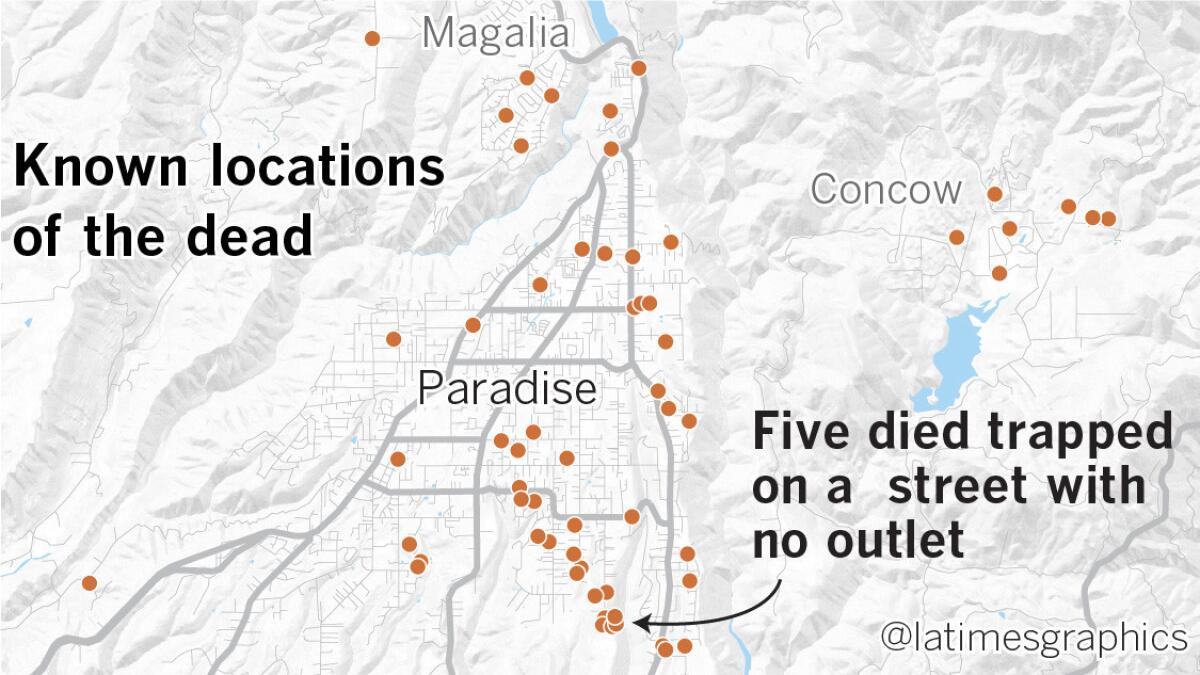
Broshears said he was surprised by how quickly intersections became a choke point. Traffic backed up on secondary roads so solidly that motorists were trapped on dead-end streets. On one, Edgewood Lane, the bodies of five people were recovered in or just outside their cars. Firefighters were summoned to rescue burn victims at the end of another, after they attempted to flee down a horse trail.
Motorists for the most part did not panic, and stayed in their slowly moving cars as the wind-driven fire shifted around them, requiring detours and double-backs and turning the 16-mile exit into a five-hour escape. By 3 p.m., seven hours into the exodus, Paradise Mayor Jody Jones said, the evacuation was complete.
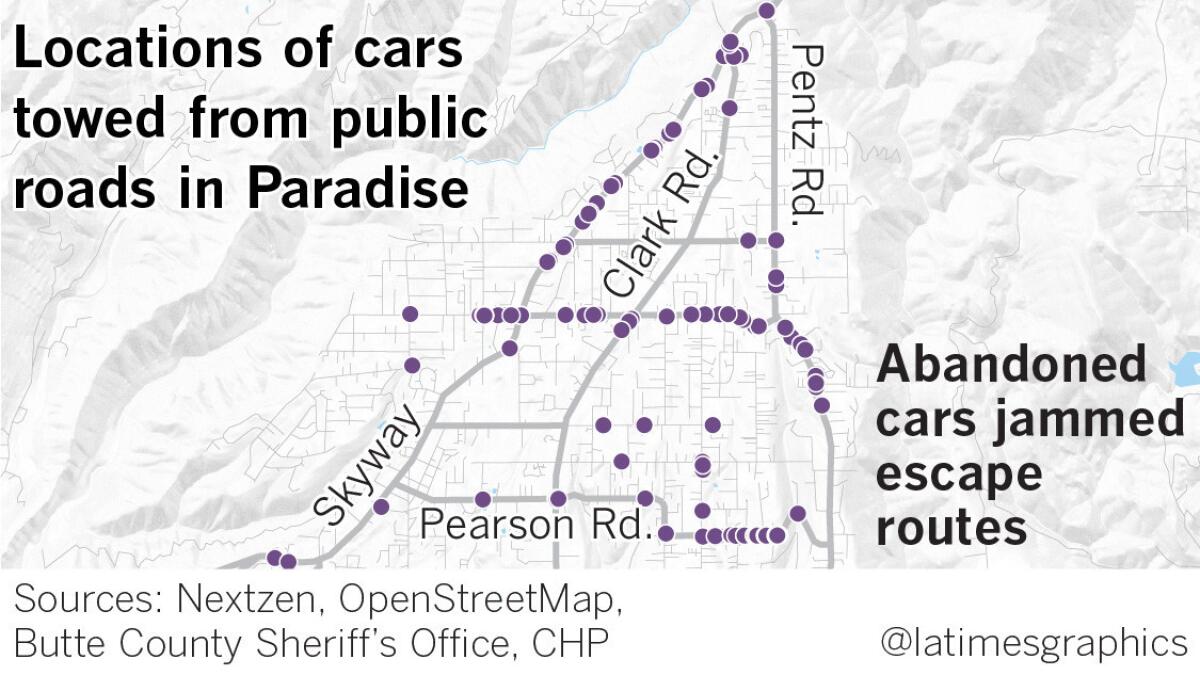
But at the north end of town, firefighters radioed reports of civilians leaving their cars and running on foot, leaving behind a blockade of abandoned vehicles. Hundreds of residents had to ride out the fire until heavy equipment arrived to bulldoze a path for buses to carry them out.
Lessons from Paradise
In the aftermath, local emergency leaders defended their preparations. The scale of the disaster, they said, would have been much worse had Paradise not repeatedly conducted drills.
“We set the goal on traffic control,” said Hawks, the city’s fire chief. “We set the bar on evacuations.”
Broshears said he wants an intensive study “to account for every decision that was made.” He now favors a siren system that could warn everyone at once, and better plans to do what Paradise did by default — shelter people in place when escape is not possible.
Mattox, the town engineer, said he wanted to “dispel the narrative” that people died while trapped on Skyway in traffic. But he said Paradise should grade new emergency routes out of town.
During the early hours of the fire, Mattox stood in the smoke directing traffic on Skyway and watched his own family pass by. He lost his home. He now struggles with the question of whether Paradise failed to heed warnings of a wind-driven fire.
“I don’t want to say ‘No, we weren’t prepared’ because we worked so hard,” he said. “And what would have been different? I just don’t know.”
Times staff writer Jon Schleuss contributed to this report.

Video from Skyway Road in Paradise shortly after the Camp fire. (Carolyn Cole / Los Angeles Times)
More to Read
Sign up for Essential California
The most important California stories and recommendations in your inbox every morning.
You may occasionally receive promotional content from the Los Angeles Times.












